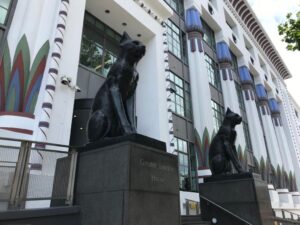Buckingham Palace, the official London residence of the British monarch, is a building steeped in history. While it may be best known for its iconic façade and the Changing the Guard ceremony, the interior is equally remarkable. With an astonishing 775 rooms, Buckingham Palace is a maze of grandeur and magnificence. Each room inside the Palace narrates a different story, reflecting centuries of British history, art, and culture. A walk through these rooms allows visitors to appreciate the legacy and continuing significance of the British monarchy. While only a select few rooms are open to the public, each one offers a fascinating glimpse into royal life. This article will guide you through some of the most important and fascinating rooms within this historic building.
Listen to London History Podcast Episode 114: Buckingham Palace
The State Rooms
The State Rooms of Buckingham Palace, open to the public during the summer, provide an intimate glimpse into the grandeur and history of the British monarchy. Each room tells a story about the monarchy’s past and present, making them not only beautiful but also richly symbolic. Whether it’s the grandiosity of the Ballroom or the refined elegance of the White Drawing Room, these spaces exemplify the enduring allure and significance of the Palace.
The Ballroom
The largest among the State Rooms, the Ballroom, is an architectural marvel. Opened in 1856 to mark the end of the Crimean War, the room is a testament to the Palace’s historical significance. This grand room, with its intricate frescos, musicians’ gallery, and imposing Throne Canopy, can seat up to 170 guests. Nowadays, it’s primarily used for State banquets, where King Charles III hosts guests ranging from diplomats to dignitaries.
The Ballroom of Buckingham Palace is more than just a grand space for state banquets; it is a living testament to the British monarchy’s history and the nation’s cultural heritage. Every element within the room, from the architecture to the artwork and furniture, has been thoughtfully curated, contributing to the ongoing narrative of the British monarchy. In its splendour and sophistication, the Ballroom exemplifies the timeless elegance that Buckingham Palace is renowned for. Its richly decorated interiors make it one of the most impressive rooms within the Palace. Here’s a closer look at this magnificent room, its artwork, and its furniture.
Architecture and Design
The Ballroom is the largest multi-purpose room in Buckingham Palace, extending 36.6 meters long, 18 meters wide, and 13.5 meters high. It was added to the Palace by Queen Victoria and Prince Albert in 1853-1855, designed by architect Sir James Pennethorne.
The room’s design reflects the fashionable Italianate style of the period, inspired by the Renaissance palaces of Rome and Florence. The grand scale, the rhythmic series of pilasters (columns), the sculpted frieze, and the expansive barrel-vaulted ceiling all contribute to the room’s majestic aura.
Artwork
The Ballroom boasts an extensive collection of artwork, most notably the impressive frescos adorning the ceiling. These frescos were painted by the renowned artist, William Kent, and they depict the victories of Arts and Sciences over Ignorance.
One of the room’s most striking features is the Throne Canopy located at the far end. The canopy houses the chairs used by Queen Elizabeth and the Duke of Edinburgh during the coronation ceremony in 1953. Above the canopy, a dramatic fresco depicts the heroic St. George vanquishing the dragon.
Flanking the Throne Canopy, two large paintings by Thomas Gainsborough are displayed: one of George III and Queen was originally built by King George IV in 1826, and is an impressive example of the neoclassical style. Its walls are adorned with many artworks, including portraits of famous kings and queens, and intricate mosaics featuring scenes from classical mythology.
The Grand Staircase
The grand staircase is one of the most iconic features of Buckingham Palace.
Furniture
The furniture within the Ballroom must be flexible to accommodate various events but always maintains an essence of royal sophistication. For state banquets, the room is laid out with a horseshoe-shaped table adorned with candelabra and flower arrangements, accommodating up to 170 guests. The settings are incredibly elaborate, with six pieces of cutlery, six glasses, and several pieces of the finest china for each guest.
Perhaps the most extraordinary piece of furniture within the Ballroom is the grand piano, often used for musical entertainment during official events. This finely crafted instrument, frequently adorned with candelabra, reflects the importance of music within royal ceremonies.
Another remarkable piece is the Sideboard, or ‘Buffet,’ designed by Ludwig Grüner in the mid-19th century. This ornate gilded piece, laden with figures and embellishments, is typically used to display pieces from the Grand Service, the collection of silver-gilt tableware used for state banquets.
The White Drawing Room
The White Drawing Room is perhaps the most elegant of all the State Rooms. As a royal reception room, King Charles III and other members of the royal family gather here before official events. The room’s breathtaking design features ornate details and a white and gold colour scheme, which contributes to its regal aura. This room, where the monarch often receives distinguished guests, provides a glimpse into the pomp and pageantry of royal life. A secret door in the room, hidden within the wall behind a mirror and a cabinet, allows for a discreet entrance and exit for the monarch.
The Interiors
The White Drawing Room is resplendent with gold décor, shimmering chandeliers, and grand white and gold furniture in the Louis XVI style, much of it from the Brighton Pavilion, which was sold by Queen Victoria to redecorate the Palace. These elements create a sumptuous setting that exudes elegance and grandeur.
At the far end of the room, behind a hidden door camouflaged by a mirror and a cabinet, is the secret passage that leads to the former Queen’s private apartments. This door allowed the Queen to make discreet entrances to the room during official functions. King Charles III still remains at Clarence House.
Artwork
Brimming with artistic splendour, the White Drawing Room houses an array of remarkable artworks. Prominently featured is a portrait by Thomas Gainsborough of George III and Queen Charlotte, the monarch and consort who originally purchased Buckingham House, which later evolved into the present-day palace.
Complementing this piece is another Gainsborough masterpiece, a portrait of their two daughters, Princesses Mary and Louisa. The strong family theme resonates with the room’s purpose, often used for intimate gatherings before significant royal events.
Furniture
The furniture, in the style of Louis XVI, is another testament to the room’s historic importance. There are magnificent gilded sofas, chairs, and footstools, all upholstered in white satin. These pieces, together with the ornate white mantelpiece clock, candelabra, and a grand piano by the renowned firm of S & P Erard, create an ambience of regal luxury and comfort.
A Spectacular Chandelier
Hanging from the ornately decorated ceiling, adorned with intricate gold leaf work, is a grand chandelier. This glittering centrepiece, made of delicate crystals, adds to the room’s luminosity and splendour.
The Music Room
This large octagonal room, known as the Music Room, holds a unique place in royal history. It has been the setting for several royal christenings, using the Lily Font, including those of Prince Charles and Prince William. Its significant features include the grand piano and exquisite, intricate window designs that fill the room with natural light.
Buckingham Palace, a symbol of the British monarchy, is famed for its stunning architectural beauty and lavish interior decor. One of the most intriguing rooms within the Palace is the Music Room, a grand setting for royal christenings, receptions, and occasional concerts. This article offers a comprehensive account of the Music Room’s design, artwork, and furniture.
Design and Architecture
The Music Room, also known as the Saloon, is an oval-shaped room located on the west front of the palace. It was designed by John Nash, a prominent architect in the early 19th century known for his neoclassical style. The room is marked by its high domed ceiling and a large glass skylight, which bathes the room in natural light during the day.
A key architectural highlight is the pair of magnificent French doors leading out to the West Terrace, allowing an uninterrupted view of the beautiful palace gardens. The doors are framed by intricate Ionic columns that add a touch of classic grandeur to the room.
Artwork
The Music Room boasts a variety of art pieces, including notable paintings, sculptures, and fine porcelain. Over the fireplace hangs a painting by Thomas Gainsborough, featuring George III and Queen Charlotte, the original inhabitants of the Palace.
Also notable are the Sevres porcelain vases placed around the room. These fine examples of French craftsmanship were part of a collection amassed by George IV. Their delicate paintings and exquisite gilding make them worthy of admiration.
Furniture and Decor
The furniture in the Music Room adheres to the regal ambience of Buckingham Palace. Gilded armchairs and sofas upholstered in sumptuous silks provide comfortable seating. An antique grand piano, often used for intimate royal concerts, takes pride of place in the room, further enhancing the musical theme.
The decor and furniture resonate with the Rococo revival style, characterized by ornate decoration, curved forms, and elaborate detailing. Handmade rugs, marble tables with gilded legs, and the finest silk curtains adorn the room, while stunning crystal chandeliers hang from the ceiling, casting a warm, inviting glow.
The white and gold colour scheme of the room enhances its airy, spacious feel, and mirrors mounted into the wall panelling create an illusion of increased space. Gilded mouldings and hand-painted cherubs add a final touch of opulence to this elegant room.
The Blue Drawing Room
Originally conceived as part of the ballroom in architect John Nash’s original design for the Palace, the Blue Drawing Room is now often used for drinks receptions. The room is known for its impressive blue and gold décor, inspired by the famous Blue Drawing Room at Carlton House, the former London residence of King George IV.
Within the regal expanse of Buckingham Palace, a multitude of rooms dazzle visitors with their opulence and grandeur. One of these, the Blue Drawing Room, is an emblematic embodiment of royal sophistication and design. This article offers a detailed account of the Blue Drawing Room, delving into the intricate features, iconic artworks, and elegant furniture that adorn this magnificent space.
Architectural Grandeur
The Blue Drawing Room is located on the west front of Buckingham Palace and was initially intended to be part of a suite of rooms by architect John Nash. Named for the blue silk damask that lines its walls, the room was initially designed as the palace’s ballroom before the Ballroom’s completion in 1856. The room’s defining architectural feature is the stunningly detailed ceiling, embellished with intricate stucco patterns, alluding to the room’s past as a grand entertaining space.
Artwork and Treasures
The Blue Drawing Room is a testament to the royal family’s passion for art, with numerous masterpieces gracing its walls. These include paintings from esteemed artists like Canaletto and Thomas Gainsborough, as well as many family portraits of royal lineage.
A standout piece is Canaletto’s “The Bacino di San Marco on Ascension Day,” a beautiful depiction of 18th-century Venice that exhibits the artist’s exceptional ability to capture light and detail. Also on display is “George III and the Prince of Wales Reviewing Troops,” a vivid representation of royal military engagements by the revered British painter, Thomas Gainsborough.
Another treasured artwork is “The Madonna of the Rosary with Saints,” by the Baroque artist Luca Giordano. This painting, placed over the grand fireplace, offers a striking juxtaposition of religious art within a royal context.
Furniture and Decor
The furniture in the Blue Drawing Room is as much a part of its opulence as the artworks. The room showcases fine British craftsmanship, with giltwood furniture and ornate ceramics enhancing its aesthetic appeal.
The room’s most distinguished furniture piece is a grand piano by S & P Erard. This finely crafted instrument, often used in royal performances, is adorned with painted panels and gilded decorations, reflecting the room’s overall style.
Another eye-catching feature is the pair of Louis XVI Ormolu and Jasperware-mounted Blue John vases. Made by Matthew Boulton, these vases, with their stunning blue hue, stand in harmony with the room’s colour scheme.
The Picture Gallery
Hidden within the majestic confines of Buckingham Palace lies a magnificent celebration of fine art — The Picture Gallery. This extensive and precious collection is a testament to the British monarchy’s centuries-long patronage of the arts. The Picture Gallery houses an exquisite selection of European masterpieces, offering visitors a breathtaking journey through the evolution of Western art.
The Design of The Picture Gallery
The Picture Gallery in Buckingham Palace is an elongated, narrow room designed purposely to display the finest paintings in the Royal Collection. The long, gallery-style layout, with its skylight roof, allows for natural light to illuminate the works and give visitors a clear view of the masterpieces from different angles. The vivid red walls of the gallery provide a striking backdrop to the array of paintings, creating an atmosphere of grandeur and reverence.
The Artistic Masterpieces
The Gallery’s collection is a veritable ‘who’s who’ of European art history. Works from renowned artists such as Titian, Rembrandt, Vermeer, and Van Dyck grace the gallery walls.
Among the notable works is Titian’s “Diana and Actaeon,” a Venetian masterpiece from the 16th century, known for its mythological narrative and the masterful depiction of the female form. Rembrandt’s “The Shipbuilder and his Wife” is another highlight, showcasing the artist’s ability to capture intimate human moments and his innovative use of light and shadow.
Johannes Vermeer’s “The Music Lesson” is another precious jewel of the collection. Vermeer’s works are known for their rarity and extraordinary quality, and “The Music Lesson” is no exception. This intimate scene, showing a lady at a virginal with a gentleman at her side, is a remarkable example of Vermeer’s mastery over light, perspective, and detail.
Sir Anthony Van Dyck’s equestrian portrait of Charles I, “Charles I on Horseback,” is also part of the collection. This iconic work shows the king in a powerful pose, reflecting the majesty and authority of the monarchy during his reign.
The Picture Gallery Today
The Picture Gallery continues to be used for royal receptions to this day. This provides the royal family with the unique opportunity to live with and enjoy these artworks daily. During state visits and official events, guests have the privilege of viewing these masterpieces up close — an experience akin to a private tour of one of the world’s finest art collections.
The Picture Gallery is more than just a room within Buckingham Palace; it is a living testament to the British monarchy’s enduring relationship with the arts. As visitors walk through this gallery, they don’t just see individual paintings; they experience a vivid tapestry of European art history — one that continues to be a source of inspiration and awe. The Picture Gallery, with its carefully curated collection, reaffirms Buckingham Palace’s status not only as a royal residence but also as a treasure house of exceptional art.
The Private Apartments
The private apartments are Elizabeth II’s personal quarters and are off-limits to the public. They include the former Queen’s bedroom, a private sitting room, dressing rooms, and a private bathroom. These rooms are decorated more modestly than the State Rooms, offering a comfortable and private living space for the then-monarch.
The Throne Room
The Throne Room, often used for formal photoshoots, houses the two thrones used for the Queen’s coronation ceremony in 1953. The thrones, under a canopy, stand before a vibrant backdrop designed by the architect John Nash.
The State Dining Room
One of the principal State Rooms, the State Dining Room, is notable for its impressive chandeliers and the portrait of Queen Elizabeth II by Pieter Pourbus. This room is primarily used for luncheons, dinners, and other grand events.
The Gardens
Situated in the bustling heart of London, the gardens of Buckingham Palace offer a tranquil and verdant retreat from the urban landscape. The largest private garden in London, this 39-acre wonder is a testament to the art of British horticulture and a fascinating part of the royal residence. The gardens serve not only as a private oasis for the Queen but also as a stunning backdrop for official events and receptions, including the Queen’s annual Garden Parties.
Layout and Design
The overall layout of Buckingham Palace Gardens has remained largely unchanged since the reign of Queen Victoria. The primary exception is the addition of the Waterloo Vase and the palace tennis court. The landscape is primarily informal, with sweeping curves and large expanses of immaculate lawn, following the naturalistic style popular in the 19th century.
Flora and Fauna
With over 350 types of wildflowers and 200 trees, the gardens are a diverse habitat for London’s wildlife. Various species of birds, including the tawny owl and the treecreeper, have been spotted here, along with a number of bats and a large population of frogs.
One of the most distinctive areas of the garden is the rose garden, where blooms of every colour create a sensory delight. Another feature is the summerhouse, which is surrounded by a stunning display of delphiniums in the summer. A wildflower meadow, complete with beehives, provides a habitat for pollinators and aids in honey production.
The three-acre lake, created in 1828, is a key feature of the garden. It’s home to several types of waterfowl, including a pair of mute swans. The lake’s island is a protected bird sanctuary, adding to the garden’s rich biodiversity.
Historical Monuments
Scattered throughout the gardens are a number of historical monuments and sculptures. Among them is the Waterloo Vase, standing at an imposing 5.5 meters tall. Crafted from Carrara marble, it was initially intended as a gift for Napoleon Bonaparte. However, following his downfall, it was presented to Prince Regent, later George IV, who decided to place it in the gardens.
The gardens also feature a striking bronze statue of Queen Victoria and Prince Albert in Saxon attire, unveiled by Queen Victoria in 1863.
Events and Activities
The gardens are known for hosting the King’s Garden Parties, a tradition since the 1860s. Invited guests – around 30,000 each summer – roam the grounds and enjoy tea and snacks, honouring their positive impact on their communities.
Occasionally, the gardens also serve as a sports field. King George VI and King George V were both avid tennis players, and the garden’s hard court has been the site of many royal matches.
Listen to London History Podcast Episode 114: Buckingham Palace




